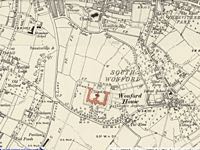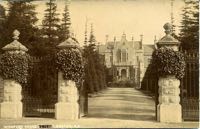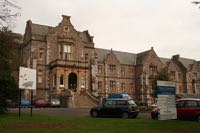
Exe Vale Hospital, Wonford House
Page updated 2nd January 2015
In 1842, the Metropolitan Commissioners in Lunacy reported on the City of Exeter Lunatic Asylum, recommending that it increase the size of its grounds for the patients. As a result, the Governors of the Asylum decided, that rather than extend the present institution, they would build a new facility to improve the treatment of their patients. Twenty acres of land was acquired at Wonford in Heavitree.
Mr W F Cross was employed as architect, while Messrs Moass (J Moass and W Moass) were the contractors. Mr Cross died before it was completed and the work was taken on by Mr Cummings, who suffered from ill health, and who also died before the building was complete–the project was completed by Mr Charles E Ware, the Town Surveyor; not the best way to complete the construction, although the final building was very close to the original design.
The builder was Messrs Samuel Moass and Sons of Exeter, who charged £28,210 for the building, with the gas installation, grounds and entrance lodge priced separately. The design for the grounds was not skimped, to ensure the inmates had a pleasant environment to exercise in. The design by the gardener, Mr James Enstone, for the new hospital won first prize from Sir John Duckworth, Bart. The foundation stone for the main building was laid on the 18th October 1866. The 420ft (128m) wide building is constructed from blue Westleigh limestone and dressed with white lias from Somerset.
The hospital opens
The Earl of Devon opened the 120 bed Wonford House on the 7th July 1869. The new building was large and airy, with a grand entrance up a flight of steps. A billiard room was included for gentlemen, and social spaces provided for the patients to mix. Dr Shapter, the chronicler of the Exeter cholera outbreak, already a physician at the Asylum, was appointed to the hospital.
There were four classes of patient, according to their needs and ability of relatives to pay for treatment.
The month after the construction was complete, the 70 workmen engaged in the work were treated to a supper at the Valiant Soldier Inn in Magdalen Street. Mr J Moass was in the chair, and the health of the hospital committee was cordially drunk to, by the ensemble of workers.
The chapel
Within 8 years the architects for the hospital were looking to contract a builder to add a kitchen and chapel to the existing complex. On 31 July 1874, an advert appeared in the Western Times for designs to be submitted for the work. A premium of £40 was offered for the best design. The cost was £1,800, exclusive of fittings and furniture–only £538 was raised, and the mortgage was for £920. The chapel was opened on 11 November 1876. There was seating for 150
Due to a lack of mains service, the hospital was self sufficient for water, supplied from wells. The capacity of the hospital seemed to have been stable through the intervening years, and by 1914 the number of in patients was 117. The quality of the food is unknown, but an advert suggests that the inmates were well fed. Tenders were advertised in the local press for food stuffs–one such was for "BEST FRESH BUTTER to the hospital for three months or six months from the 1st December 1915." It is likely that flour, milk and similar foods were purchased in this way, although fresh vegetables and fruit were provided by the hospitals exstensive gardens and farm–the surplus was taken to market by horse and cart.
The patients could enjoy an archery range, a croquet lawn and a cricket pitch. Inside the patients were provide with music, and billiards.
Memories of the hospital
Olwen Foggin Thomas remembered of her time working at the hospital "A story I was told about during the war, (was when the) night staff contacted the police because they thought someone was spying on them. It turned out to be the head of a pilot up a tree whose plane was shot down at the Barracks–up until the 1960, youth from Wonford attended the Tuesday night dance and what wonderful dancers there was to–then there was the christmas staff dances, and pantomimes. Wonford house was self sufficient in garden produce way into the 1960s–we used to get the milk from Charlie Smith's Dairy."
Now named, Exe Vale Hospital, the main Royal Devon and Exeter Hospital is situated just to the north of the old Wonford House building. The hospital treats patients with eating disorders and is the location of the Wonford House Hospital Library.
Sources: Exeter and Plymouth Gazette, Western Times,The Royal Devon & Exeter Hospital 1948-1998 A Better Provision - 50 years on by Hazel Harvey and The Royal Devon and Exeter Hospital by Andrew Knox and Christopher Gardner-Thorpe.
│ Top of Page │



